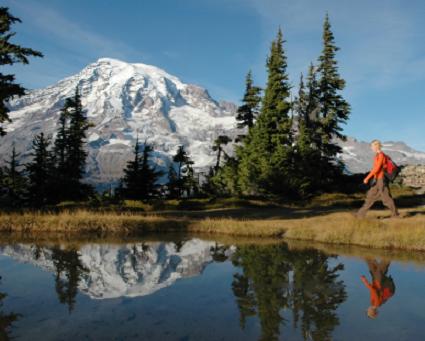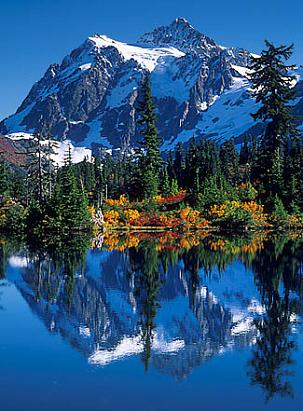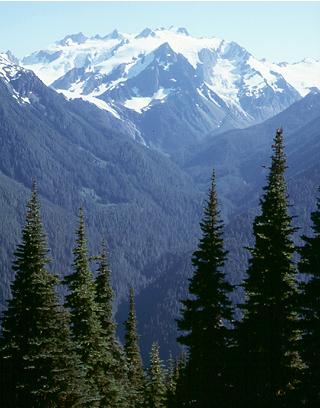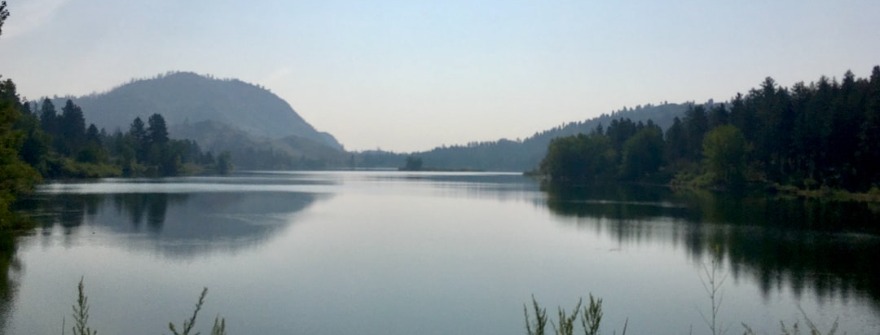Three national parks of great acclaim and beauty are present in Washington. The highest point in the state is the snow-capped Mount Rainier that stands tall at over 14, 400 feet. Several passionate and serious mountaineers attempt to surmount the peaks while the surrounding Mount Rainier National Park offers the perfect outing for the whole family. The Olympic National Park with a Pacific shoreline is spread over 920,000 acres and has a wide variety of scenic locations as apart from the characteristic alpine meadows, mountain peaks and rain forests there are several beautiful lakes and streams. North Cascades National Park holds the Cascade Mountain ranges and several recreational areas.
Mount Rainier National Park, Washington
Set in its own national park, the glacier-clad Mount Rainier is the highest and most accessible peak in the Cascades. The weather here is often very wet; not until midsummer does the snowpack melt enough to unblock roads. This is the time when the deer and mountain goats appear, the alpine meadows become ablaze with dazzling flowers, and Mount Rainier makes for some perfect hiking.

The 14,410 feet Mount Rainier is the park’s central attraction. It holds the distinction of being the highest peak in the Cascade Range. It is also one of the world’s most massive volcanoes. Climbing Mount Rainier itself is hazardous and should be undertaken by experienced climbers with the necessary equipment. During the summer, you can also drive the 240 miles of roads that almost circumnavigate Mount Rainier National Park to the various entrances.
If you have only a day to explore the park, consider traversing the south and east sides from Nisqually entrance to Paradise, with a side trip to Sunrise. The stunning 80-mile drive winds through river valleys and lowland forests with glaciated peaks and magnificent views. There are numerous trails radiating from Paradise, such as the 5-mile Skyline Trail to Glacier Overlook, the perfect spot to view the awesome Nisqually Glacier.
Detailed Travel Guide to Mount Rainier National Park
North Cascades National Park, Washington
The North Cascades National Park preserves the idyllic beauty of the northern part of the snowcapped and pine-covered Cascade Mountains. The Cascades offer mile upon mile of forested wilderness, stretching from Canada down to Oregon, traversed by beautiful trails. Hwy – 20, the high mountain road that crosses the Cascades, is by far the most spectacular route top eastern Washington.

Almost 400 miles of trails and wilderness allow visitors to experience nature. The Cascade Loop, a 350-mile round-trip that channels tourist traffic along the major highways in this region, provides the opportunity to drive amongst some of the most gorgeous scenery in the country. The complete trip is feasible only during the summer, since at other times snow closes the mountain passes, and can be rather exhausting if driven all at once.
Unless you have at least three full days to explore this territory in full, you’re better off choosing a few selected treks through the incredibly beautiful landscape. The towns themselves are best taken simply as bases for your travels, rather than as tourist destinations. Hwy – 20 begins its long journey inland at Anacortes, from where it crosses the coastal plains, passing the North Cascades National Park Information Center. Here, you can get information about the most popular trails and ranger-led programs.
The best time to visit this park is from mid-June to late-September. Visitors should remember that the weather is unpredictable. Summer storms are common. Those visitors who plan on traveling into the backcountry should be prepared for such conditions.
Olympic National Park, Washington
The stunning Olympic National Park, covering much of the peninsula’s mountainous interior and a 57-mile strip of the Pacific coast, was created in 1938 by Franklin Roosevelt, partly to ensure the survival of the rare Roosevelt elk. The park now has the largest remaining herd in the US. More than two hundred miles of wild rivers wind through the park, while the valleys of the rivers preserve sizeable tracts of temperate rainforests.

The Olympic National Park is a UNESCO World Heritage site. The weather here is consistently erratic and often rainy; there is a fair amount of snow as late as June. No roads cross the park, but many run into it, so you’ll probably end up making several forays into the different sections around the peninsula’s western rim. The main visitor center marks the start of a winding road that climbs seventeen miles to Hurricane Ridge, where the peaks and sparkling glaciers of the Olympic Mountains are spread majestically.
The Park has several opportunities for hiking. Hurricane Hill Trail (three miles round trip) is a moderate hike, climbing through wildflower meadows to the peak where, on a clear day, you can see Cape Flattery, the Straits of Juan de Fuca, Vancouver Island, and the Cascade Mountains. In winter, transit buses climb up to the ridge for excellent cross-country skiing.
Ten miles west of Port Angeles, the glacially carved Lake Crescent is popular for trout fishing. There is a tourist lodge here which is the best place to stay on the peninsula. Visitors can also Sol Duc Hot Springs, where mineral-rich waters bubble out of the ground.
